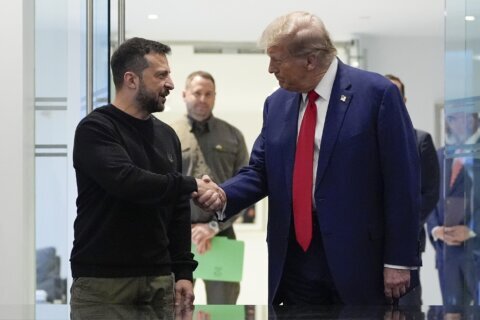High school senior Jennifer Zhao says she was always interested in American culture and education, given that she had attended the bilingual YK Pao School in China since the first grade and had participated in the exchange program at St. George’s School in Rhode Island. When it came time to apply to universities, the U.S. was naturally her top choice.
“Although the pandemic and the former Trump policies against international students made the situation challenging for me, as a Chinese student, the cancellation of the SAT requirement for most U.S. universities was the primary incentive for me to continue applying to U.S. universities,” Zhao says. She submitted applications to 17 U.S. colleges and universities.
Zhao says the fact that many schools have implemented test-optional admissions amid COVID-19 meant she could highlight other elements in her application, like leadership experience, “allowing me to aim higher for reach schools.” She will begin the global liberal studies program at New York University in fall 2021.
While international student enrollment in U.S. colleges and universities declined in 2019-2020, per the latest Open Doors Report on International Education, the U.S. remains at the top of the list for many prospective international undergraduate and graduate students.
[Read: Annual Study: International Student Numbers in U.S. Drop.]
“Higher education in the United States is still the gold standard for both personal and professional development and advancement,” says Linda Gentile, director of the Office of International Education at Carnegie Mellon University in Pennsylvania.
Here are three of the biggest reasons to study at a U.S. college or university:
— U.S. degrees have an outstanding international reputation.
— The education system is flexible and offers research opportunities.
— U.S. colleges are making an effort to recruit and retain international students.
U.S. Degrees Have an Outstanding International Reputation
American universities are among the top-ranked institutions in the world and known globally for their reputation.
“United States colleges and universities continue to dominate global rankings. Among the Nobel Prize winners since 1901, 1,259 have studied or conducted research in the U.S. Of those, seven have been Stony Brook faculty,” says David Bousquet, interim vice president for enrollment management at Stony Brook University–SUNY in New York.
The solid reputation of U.S. schools was a big draw for Eleni Kytoudi, who is from a small agricultural village in northern Greece and the eldest child of farmers. She credits her time at the American Farm School in Thessaloniki, Greece, for setting the wheels in motion.
“After spending two summers in the U.S. at college preparation summer programs facilitated through my high school, I knew I wanted to come here,” says Kytoudi, now a junior double majoring in economics and government at Franklin & Marshall College in Pennsylvania.
Many international students are drawn to U.S. schools for their high academic standards and training they provide, which can be advantageous for employment opportunities anywhere in the world.
“When graduates are applying for jobs, a degree and work experience in the United States will make them stand out amongst applicants. It will show employers that they are adaptable, bilingual, experienced and willing to take on a challenge,” says Amy Malsin, a spokesperson for The New School in New York. “This is critical for our graduates as they apply for jobs in their home countries or use their connections in the U.S. to get work visa sponsorship.”
The Education System Is Flexible and Offers Research Opportunities
Another big reason for international students to study in the U.S. is the large variety of courses and programs and the flexibility offered, such as allowing undergraduate students to declare their major at the end of the second year.
“American universities encourage students to pursue a curriculum founded on the belief that interdisciplinary study is invaluable to a student’s personal development. Students will combine courses in the liberal arts and STEM disciplines in completing their degree requirements,” Bousquet says, referring to the fields of science, technology, engineering and math.
[READ: What a U.S. Liberal Arts Education Can Provide International Students.]
Unlike universities in the United Kingdom, for example, that require students to choose a major when applying and to remain in that field once enrolled, U.S. universities give students more time to explore different courses.
“Many students in their home countries didn’t know what they wanted to major in, but when they got to take various classes at Stony Brook University, they found it challenging and enriching and they enjoyed studying in these different areas. This opportunity to explore these various disciplines provided students with the possibility of expanding their career prospects,” Bousquet says.
In addition to the exposure to different disciplines and time to decide on a major, international undergraduate and graduate students have many research opportunities at U.S. schools, experts say.
For instance, “the University of California–Berkeley presents students with a unique opportunity to interact with faculty engaged in cutting-edge research,” says Ivor Emmanuel, director of the Berkeley International Office. “This places students in a learning environment that is at the cusp of the latest of what research and teaching offers across multiple disciplines.”
Indian national Smeet Dinesh Chheda, who is pursuing a master’s in computer science at Stony Brook, worked on a research project with Brookhaven National Laboratory through its affiliation with the university’s on-campus research lab, Exascallab.
“I received this wonderful opportunity to work and collaborate with an excellent researcher through the university,” says Chheda, who has applied to the school’s computer science Ph.D. program. “I’d say that it would be much more difficult to get the same opportunity if it weren’t for the university lab.”
U.S. Colleges Are Making an Effort to Recruit and Retain International Students
Due to U.S. immigration policies and the response to the coronavirus pandemic, some prospective international students applying to American universities in the previous admissions cycle “geo-swerved” — meaning they made sudden decisions to select different countries in which to study — says Julia Gooding, founder and CEO of One Sky Education, a boutique international education and student admissions consulting firm with offices in Shanghai, London and Portland, Maine.
But U.S. schools have been working to change that by ramping up their efforts to recruit international students. A Fall 2020 International Student Enrollment Snapshot by the Institute of International Education shows 82% of institutions reporting increasing virtual recruitment and 64% committing funding for outreach and recruitment at the same level or higher than previously.
At Stony Brook, for instance, the international team has conducted more than 500 virtual college fairs since the pandemic lockdowns, Bousquet says, and staff have been virtually visiting and connecting “with prospective students, their parents and institutions in many regions that have historically been inaccessible due to travel or cost considerations.” Examples include countries like Iran, Afghanistan, Cuba, Uzbekistan and Ethiopia, he says.
Colleges are also working to retain international students. For new and continuing international students enrolled during the pandemic, Bousquet says his school reached out to partner with universities across the globe to implement “SBU Home Abroad” to provide students “the opportunity to study in-person in their home country while maintaining registration and academic progress at SBU.”
[Read: Maximizing U.S. University International Student Services After Enrolling.]
Similarly, Franklin & Marshall has created virtual programming and engagement opportunities aimed at international students in different time zones, says Sue Mennicke, associate dean for international programs.
For example, she says the school developed a program in China offering specially designed courses taught by university faculty to first-year Chinese students in order to introduce them to the academic and social experience at F&M and to keep them on track with degree requirements. The students live together in a residential facility in Shanghai.
Franklin & Marshall has supported international students in other ways. When the unexpected March 2020 lockdown occurred, Kytoudi says F&M provided extended access to campus housing and emergency travel funding for some students, for example.
Kytoudi, who spent the fall 2020 semester at home in Greece and returned to campus in January, says the school’s international student services office has been more supportive than ever.
“Merely judging by the way F&M is handling the pandemic, my decision to study here is gloriously proven to be the right one,” Kytoudi says.
Searching for a college? Get our complete rankings of Best Colleges.
More from U.S. News
American Education System: What International College Students Should Know
Campus Resources for International Students
3 Tips for International Student-Athletes
3 Biggest Reasons to Choose to Study in the U.S. originally appeared on usnews.com







